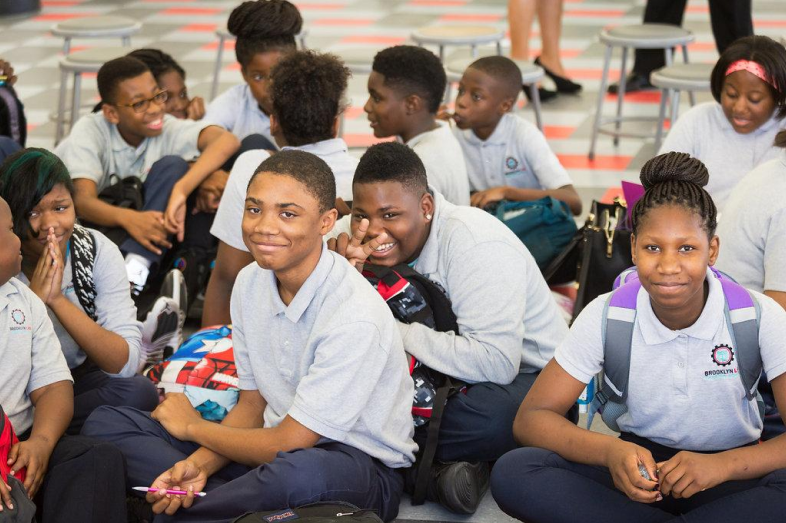

In Louisiana, a high school focused around the theme of coastal restoration will be built on a barge — yes, a barge. Two Los Angeles educators have dreamed up plans for a high school designed to serve foster and homeless children. And the Somerville, Mass., district is planning a year-round high school that “feels more like a research and design studio,” reports the Boston Globe.
Awards totaling $100 million, $10 million apiece, were announced Wednesday for these and other projects to “reimagine” the American high school. The grants support efforts to create new high schools — or transform existing ones. Some will be charter schools, others district-operated campuses.
The ten prizes come from XQ: The Super School Project. The high school redesign competition has financial backing from the Emerson Collective, an organization launched by Laurene Powell Jobs, the widow of Apple co-founder Steve Jobs.
“The Super School Project was born out of the conviction and commitment that every child from every background has a right to a quality education that prepares them for a future none of us can easily predict,” said Russlynn Ali, the chief executive officer of the XQ Institute, in a press release. (Ali has long worked in the education policy arena, including a stint as an assistant secretary for civil rights in the Obama administration.)
The initial plan was for five awards, but with more than 700 applications, the organizers expanded the prize pot to allow 10 winners.
Powell Jobs told USA Today’s Greg Toppo that she was “humbled” by the response to the competition. She and others spent a year working with 348 teams in 98 districts nationwide, many of which will push to complete their work even without XQ’s funding, Toppo reports.
Powell Jobs said she hopes the 10 schools, as well as others that XQ was honoring this week, will serve as models for next-generation U.S. high schools. “There’s enormous capacity for creativity within districts,” she told USA Today.
The effort aims to “show the country what a 21st Century high school should look like,” the XQ press release says, by redefining the use of classroom time and space, putting students at the center of learning, and making schools “hubs of the community.”
‘School Will Come to You’
Journalists from around the country have highlighted some of the winning proposals, and what they’re seeking to accomplish.
“Instead of going to school, school will come to you,” writes Joy Resmovits of the Los Angeles Times about a winner from that city. “That’s the prize-winning idea behind RISE High, a proposed Los Angeles charter high school designed to serve homeless and foster children whose educations are frequently disrupted.”
The idea is to have three to four physical sites sharing space with existing nonprofits, as well as an online learning system. A bus will be “turned into a ‘mobile resource center,’ to bring Wi-Fi, a washer/dryer and homework help to the neediest students,” Resmovits reported
In Louisiana, New Orleans Times-Picayune reporter Danielle Dreilinger highlights an especially unusual design for New Harmony High.
“What really captures people’s imagination about southern Louisiana’s proposed high school isn’t its coastal restoration mission,” she writes. “It’s not the internships or its partnership with Stanford University. It’s the campus. New Harmony High will be on a barge in Plaquemines Parish.”
Each student will have an individual education plan that addresses the many academic disciplines needed to respond to a changing coastline.
“They include ‘all of the –ologies, plus the political, planning and communication skills needed to manage a large-scale human transition’,” Steve Cochran, a member of the school’s project design team, explained to the newspaper.
In Somerville, Mass., the planned school will allow students to pursue long-term projects in areas of interest to them, reported James Vaznis of the Boston Globe.
“There would be no grade levels or a set sequence of courses in math, science, and English,” he writes. “Instead, students would learn material in theme-based symposiums, internships, and hands-on projects that could delve into biomechanics or computational art.
The Wall Street Journal’s Leslie Brody, meanwhile, looked at another winning applicant: the Brooklyn Laboratory Charter School in New York City. The charter, which current serves nearly 500 middle school students, will use the money to phase in a new high school, starting this fall. ”It won for its use of technology to track student needs and deliver relevant curriculum, as well as its extensive tutoring, new-teacher training and its success in helping children with learning disabilities, among other points,” she notes.
The Hechinger Report’s Jamie Martinez also highlighted the Brooklyn Lab School. It discussed the charter’s focus on personalized learning to better tailor instruction to students’ individual needs.
Catherine Gewertz of Education Week offers some helpful background on prior initiatives of a similar nature, in her coverage of the announcement.
“The XQ contest represents one of the biggest monied contests for school redesign,” she explains. “The biggest is still the 1993 Annenberg Challenge, which handed out $500 million in grants to school districts and partnerships to undertake a wide variety of school reforms in 18 states across the country. Grants ranged from $1 million to $53 million.” In addition, Gewertz pointed to other examples of foundations sponsoring initiatives to rework high school, including the Bill & Melinda Gates Foundation’s grants for small high schools and ongoing support by the Carnegie Corporation of New York for high school improvement.
A Cautionary Tale?
Not everyone is welcoming the plans with open arms, however. Rick Hess, the education policy director at the American Enterprise Institute, shared his “mixed feelings” about the Super Schools project in a blog post. He pointed to another example of work in this domain as a cautionary tale: the New American Schools Development Corporation launched in 1991 by corporate CEOs in response to a proposal by President George H.W. Bush.
Hess said that effort to create new school models in most cases showed no significant impact on student learning and “came to an inglorious end after more than a decade and is now another name on the list of largely forgotten disappointments.”
Hess argues that if XQ “can avoid the missteps” of a project like that,” and “temper the enthusiasm of its well-wishers, resist the faddish impulses that always plague these exercises, and avoid the temptation to be defensive about the endeavors it has now touted as socially-just ‘super schools,’” then “this could be a terrific contribution to school improvement.” But Hess said he believes “the jury is so clearly still out.”
At the Education Writers Association’s 2016 National Seminar in Boston, a variety of educators and analysts took education journalists on a “deep dive” into the issue of reimagining American high schools. Shannon Gilchrest of the Columbus Dispatch offered highlights of the discussion in a guest blog post for the Educated Reporter.
You can view descriptions of all ten winners of the XQ design challenge here, including projects in Houston, Oakland, and Grand Rapids, Mich.
